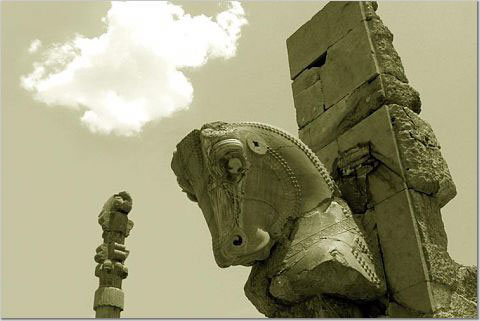

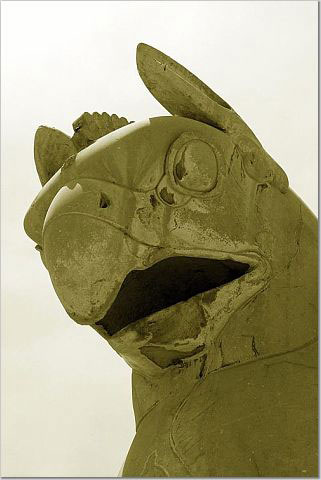


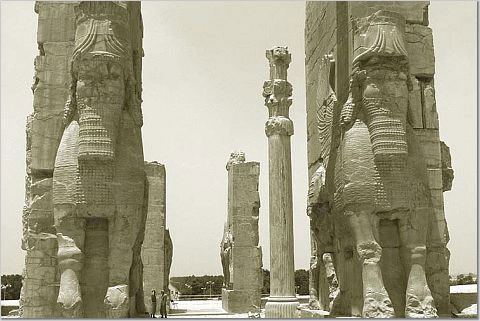
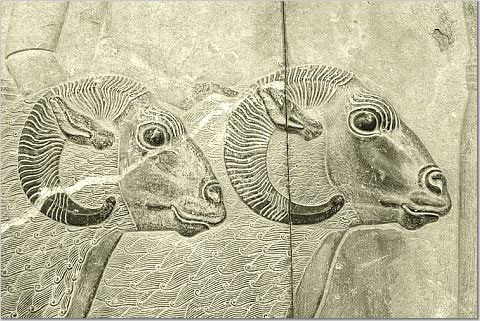
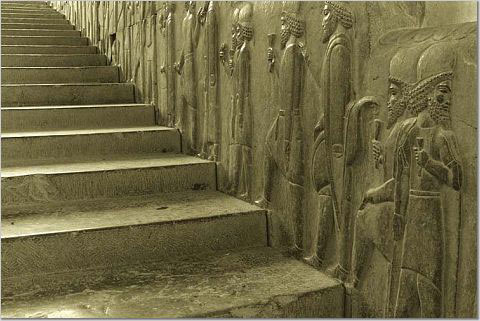

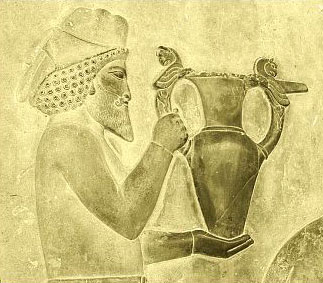
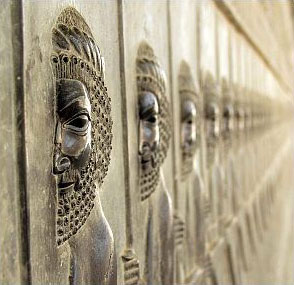
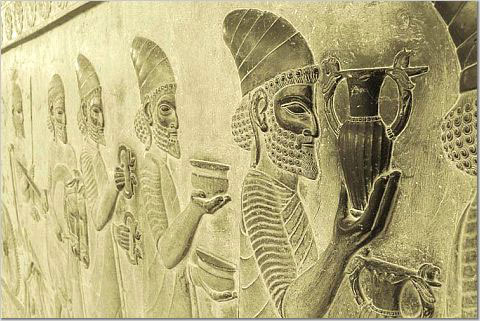
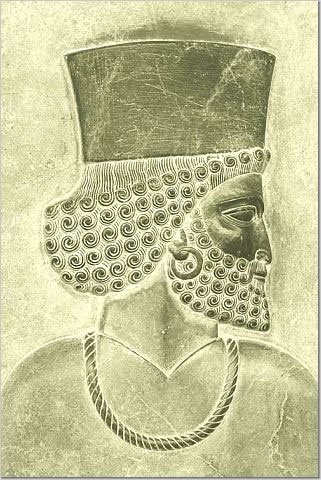
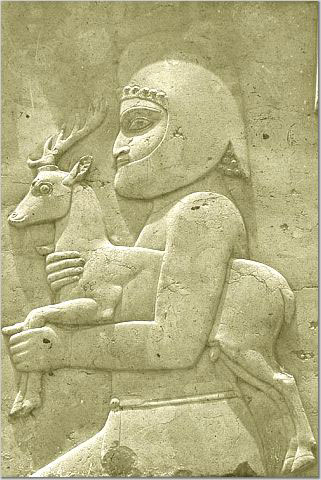
Posted on 09/05/2004 8:09:50 PM PDT by freedom44
Despite the tendency to see Iran as an Islamic monolith and the attempts of the ruling clerics in Tehran to cast it as such, the full complexity of Iranian identity is little understood and almost never discussed—even by Iranians themselves. Long before it was absorbed into the Islamic empire by Arab armies under Caliphs Umar and Uthman in the mid-seventh century, Persia had been the birthplace of Zarathustianism, or Zoroastrianism, the world’s first monotheistic religion.The religion was forged some 3,500 years ago around the philosopher-prophet Zarathustra’s teachings, which emphasized personal morality and a conscious choice between good and evil. From a vision he had while wandering the hills of Iran, Zarathustra Spitama preached that there was only one universal god of good, whom he called Ahura Mazda. In opposition stood the power of Ahriman, the “un-good”—an ancient forerunner to Satan.
Zarathustra taught that the challenge of life is to develop a “good mind,” (Spenta Manyu), reject the “un-good mind” (Angre Manyu), and embrace a life of good thought, good words and good deeds (Humata, Hukta, Havarsta), which locates the individual’s ethical choices at the center of spirituality.
Listen to the best things with your ears Reflect upon them with clear thought. And choose between the two ways of thinking. At the world’s end He, of holier spirit, that chooses the Right . . . And shall inherit the Best existence. He that follows the Lie and chooses the worst Shall inherit the worst existence . . . If you choose wrongly and rush to violence You enfeeble the world of men. If the right choice is made Then, in the hereafter, all shall be well. [Free translation from the Gathas, or Songs of Zarathustra, section 3:2]
In his comparative study of world religions, Max Weber claimed that the Zoroastrian dualism of good and evil represents one of three coherent solutions to the problem of evil, the others being the Indian doctrine of karma and the Calvinist idea of predestination. And theologians generally agree that Zarathusti notions of monotheism, heaven and hell, and the messiah and the apocalypse spread quickly and profoundly influenced Judaism, Christianity, and Islam.
When Paul Kriwaczek writes in his new book In Search of Zarathustra that in Iran, “in spite of everything, Zarathustra still lives,” he is not simply referring to the 60,000-odd surviving Zarathustis in Iran, who have nurtured the religion through 13 centuries of Islamic persecution. (There are also about 60,000 Zarathusti Parsees in India and about 35,000 Zarathustis worldwide, of which about 25,000 are in North America, including the conductor Zubin Mehta and the novelist Rohinton Mistry.) Kriwaczek is interested in something less visible. Part history, part travelogue, the book is an exploration of an ancient religion and its persistent influence in the modern world. With a remarkable blend of intellectual insight and respect for both faiths, Kriwaczek examines how the Zarathusti Persian ethos was transmuted into Islamic Iranian life.
* * *
When the Arabs conquered Zarathusti Persia in 641 C.E., it had been one of the world’s military and cultural superpowers for more than a millennium. Playing off Herodotus’s colorful accounts of Persian history, Kriwaczek tells how in 559 B.C.E. a shepherd named Cyrus united the Persian tribes to overthrow Babylon and establish the Persian Empire, the largest the world had known until that time. It stretched from the Indus in India to the Nile in Egypt. But Cyrus’s empire entered into the historical realm as much for its new, humanistic conception of the world as for its military prowess.
From Cyrus the Great’s tranquil tomb in his now abandoned capital at Pasargad and the magnificent ruins of Persepolis, Kriwaczek narrates how Cyrus’s coming had been foretold by the Jewish priests who saw him as a messianic figure. In the Old Testament the Jewish prophets called Cyrus “God’s chosen . . . the Anointed One,” the one who would free the people from slavery.
The young shepherd kept that promise. After defeating the Babylonians, Cyrus freed the Jews they had enslaved and rebuilt the first temple in Judah. He proclaimed his subjects free to worship their own gods and ruled his lands with a secular and liberal code, perhaps the world’s first universal declaration of human rights. A replica of the cylinder on which this was inscribed is kept at the headquarters of the United Nations in New York.
Cyrus’s Achaemenian dynasty (550–330 B.C.E.) also allowed local kings and nobles to govern their original realms, albeit under Persian suzerainty. All this was unprecedented; centuries later Hegel would proclaim Cyrus’s realm “the world’s first real empire . . . where one race encompasses many peoples but these people preserve their individuality in the light of the unifying rule.” (Americans might be surprised to learn that the seven-pointed halo which guilds the Statue of Liberty is linked to Mithra, a Zarathusti archangel of good governance.)
When the dynasty finally succumbed, most Zarathusti Persians converted to Islam. A few went underground, and some, including my ancestors, fled to India, where they maintained their original faith against overwhelming odds. (The community came to be known as the Parsees, or ones from Pars, the Persian name for the fabled capital Persepolis.)
The broad swath of modern history generally sees the collapse of the Persian Empire as the classical demise of one civilization at the hands of another, more powerful aggressor. Yet, as Kriwaczek suggests, a more nuanced reading of history and the reality of modern Iran reveals something else—something that my friend the sculptor was acting out as he crafted a Zarathusti Farohar in that narrow alley. “In our hearts we are still Zarathusti,” a number of Iranians quietly said to me as I traveled through the ancient cities and historical sites Kriwaczek describes in his book.
Iranians’ obvious and immutable connection to their past sits uneasily with the orthodox Islamists who rule them. “The absolutist nature of political Islam has always found it unacceptable to accede that even a trace of Zarathustianism remains in Iran,” an academic in Shiraz said to me. Like all others with whom I spoke, he requested anonymity.
Kriwaczek speculates on how Zoroastrianism survived thirteen centuries: “New converts don’t just give up their former spiritual and ethical world-view; they usually bring them along, transferring the old wine into the new bottle.” The Persians accepted the simple purity of Islam as their new faith but nevertheless found ways to preserve their heritage. “Just as in Europe the Holy Roman Empire—‘neither holy, nor Roman, nor or an empire,’ as Voltaire said—was actually a way for baptized German warlords to repackage their pagan traditions in Christian wrapping, so Iranian Islam came to incorporate Iranian national consciousness, Iranian national pride and, yes, Iranian Zoroastrian beliefs.”
Kriwaczek illustrates this point with examples drawn from Persian architecture and poetry. To show, for example, how Persian arts, culture, and science quickly infused Iranian Islam, he compares two pairs of religious buildings—the first and earlier pair a staid and pious structure (Orthodox Islam holds that it is a sin to depict any living thing), the second a structure of perfect geometry resplendent with animal and bird carvings. Kriwaczek also shows that Iranian literary traditions, as personified first by the 12th-century poet Ferdowsi—author of the Shah-nameh, or Book of Kings, the national epic of Iran—and later by the mystic poets Hafez, Sa’adi, and Rumi, are unabashedly pre-Islamic, both in treatment and content. In Shah-nameh Ferdowsi writes that
Zardosht (Zarathustra), the prophet of the Most High, appeared in the land . . . And showed the people a new faith . . . He reared throughout the realm a tree with beautiful foliage. Men rested beneath its branches . . . (and) became perfect in wisdom and faith. Islamists still struggle to understand how a good Muslim like Ferdowsi could say that another prophet than Muhammad could make men “perfect” in faith.
The poems of the mystics were so influential that they helped to initiate an entirely new branch of Islam, Sufism, which added to the earlier split between Iranians and Arabs into Shi‘ite and Sunni Islam. Expectedly, many Sunnis saw Sufism as heresy and to this day it remains banned in Saudi Arabia.
* * *
Unfortunately, while Kriwaczek artfully reveals the Zarathustian hinges of Iranian culture, his lack of concrete evidence is a major shortcoming. He also fails to mention the growing interest of many Iranians in their ancient past and faith and the possible repercussions for the country.
Modern Iran has consistently wobbled between the dual and sometimes conflicting pillars that define it: Islam, and what is now euphemistically called Iran’s “pre-Islamic heritage.” As Iran struggles to emerge from the oppressive failures of its Islamic revolution, it has grown increasingly conscious of its roots.
Despite Iran’s reputation as the harbinger of Islamic revolution, the simple fact is that Iranians never wanted an Islamic state in the way Ayatollahs Ruhollah Khomeini and Ali Khamenei have forged it. Many Iranians welcomed the re-emergence of religion in Iran after the Shah’s relentless modernism, but few wanted or expected the clerics to grab control over people’s daily lives and government.
While in most Sunni Arab countries matters of religion and state have always been inextricable, Iran’s Shi‘ite society sought to separate them. Shi‘ite clerics traditionally belonged to three schools of political thought—“loyalists” who believed in cooperation with the state, “opposers” who exercised moral suasion on the political process from the outside, and “quietists” who advocated outright withdrawal from politics. Before Khomeini, the latter were the largest group.
Khomeini introduced a radically new principle into Shi‘ite Islam: velayat-e faqih (or direct rule by the most senior cleric, i.e., himself). This novel doctrine progressively alienated Iranians and created deep divisions within the clergy, as in the current rift between the hard-line clerics led by Iran’s current Supreme Leader Khamenei (the new beneficiary of velayat-e faqih) and the reformers led by President Hojjatoleslam (the rank just below Ayatollah) Mohammad Khatami.
It is this Shi‘ite tradition of interpretive Islam and political freedom that is causing Iranians to chafe under Khamenei’s velayat-e faqih and giving rise to political changes that could produce the first and most sustainable democracy in the Middle East.
“A loss of faith with the mullahs [in government] has led to a loss of faith in the religion,” says Azar Bharami, a lawyer and women’s rights activist in Tehran. “When the government does not respect the [line] between religion and state how can people?” Numerous surveys, including one by the magazine Asr-e Ma (“Our Era”), have shown that most Iranians under the age of 25—who make up 50 percent of the overall population—consider themselves agnostic. Many young Iranians are cynical, even derisive, about their religion. Epithets like “mad mullahs” and “this thing Islam” are not uncommon.
At a time when many Iranians feel violated by the religious and political extremism inflicted upon them, but remain powerless to act against it, romantic allusions to ancient Persia offer hope. Evidence of popular fascination with Iran’s Persian heritage is everywhere. Stone carvings, paintings, and pictures of Persepolis adorn the walls of many homes, office buildings, and restaurants. In dusty bus stations across Iran’s desert towns, transport companies have painted Farohars on the sides of their sandblasted buses. Savvy marketers have also begun to tap into the trend. The newest model of the locally made Peugeot sedan in Iran has been branded Pars (Persepolis) and consumer products with names like Parsian line the shelves of Iran’s tiny street stores.
“Iranians are trying to discover who they really are,” Bharami said. “They feel shamed by their government and let down by their religion . . . they want something to believe in.” What remains mostly unsaid—not least because saying it could invite a death sentence—is that the increasing interest in Iran’s pre-Islamic past is also fueling an interest in its ancient Zarathusti religion.
“If we were allowed to convert religions, millions would convert [back] to Zarathusti,” a middle-aged Muslim man in Tehran told me. “I challenge the government to allow conversion out of Islam for even one day.”
But he is unlikely to see that day. While Islam is aggressive in proselytizing itself, it bans, by punishment of death, the conversion of Muslims into other faiths. Making matters more complex for those Iranians looking to return to their “original faith” is that the faith itself does not seem to want them. “There can be no conversion into our religion,” says Sohrab Yazdani, a leading member of the Zarathusti community in the city of Yazd, home to most of Iran’s surviving Zarathustis and their religion’s sacred sites.
Having lived as a persecuted minority for more than 1,300 years, Iran’s Zarathustis have formed a tightly knit and closed community. Few want to risk incurring the Iranian government’s wrath at a time when President Khatami has eased many of the serious discriminations their community has endured for centuries. Complicating the theological landscape is the notion that being Zarathusti, like being Jewish, is a matter of birth, not conversion. Any challenge to this closed community of faith is fiercely rejected by most Zarathustis in both Iran and India. The one movement to convert Iranians and others into Zoroastrianism, started by an Iranian named Ali Jaffery, has run afoul of both the Islamic authorities in Iran and the mainstream Zarathusti community.
Caught between their current religion, which won’t let them out, and their desired religion, which won’t let them in, some Iranians are believed to practice Zoroastrianism in secret. But if some take this risk, virtually none are willing to talk about it. However, there is growing evidence that at least one disenfranchised group in the region has indeed been turning towards Zoroastrianism—the Kurds.
Kurdish religious practices bear close resemblance in ritual style to the Zarathusti faith. The original religion of the Kurds was Yezidism, a religion greatly influenced by Zoroastrianism, and many Kurds were also Zoroastrian until the Islamic conversions that began in the seventh century. Today, about 25 percent of Kurds still practice Yezidism, which is centered around the town of Lalish in northern Iraq.
According to Dr. Pir Mamou Othman, an expert on Kurdish religious practices, “the Yezidis pray in a way which resembles the prayer-rituals of the Zoroastrians, something especially noticeable in the morning-prayer where the face is turned towards the sun. Their cycle of five prayers also stems from Zoroastrianism, and not from Islam, as is often stated.” Though 70 percent of Kurds are nominally Islamic (the remaining 5 percent are Jewish and Christian), they hold their Islam lightly, practicing a syncretic articulation of the faith that reflects their pre-Islamic past.
There are reports, mostly unconfirmed, that in the face of persecution from both Shias and Sunnis and their growing political independence, some Kurdish tribes have begun to embrace Zoroastrianism. In a rare interview on the subject, Mahir Welat—representative of the National Liberation Front of Kurdistan (ERNK) and the Kurdistan Workers Party (PKK) to the Russian Federation—said that “For a time the Kurds forgot about their Zoroastrianism roots but now it is our intention to return and to educate ourselves.”
It is not completely coincidental that it took a person in Welat’s position to make these comments. Since the fall of the Soviet Union, many people in southern Russia and the newly independent Central Asian republics of Tajikistan, Uzbekistan, and Azerbaijan, historically part of the Persian Empire, have openly embraced Zoroastrianism.
As these republics struggle to reimagine themselves as sovereign states, they are drawn to their ancient ethnic roots. Leaders of the republics, especially President Imomali Rahmonov of Tajikistan, support the resurgent interest in Zoroastrianism, which they hope might counter the radical Islam that the Saudis and others are trying to export into the region.
It's amazing the things which have survived, and particularly in this case considering that this particular faith was not necessarily well thought of by the ancient Hindu.All Consuming FaithGriffon vultures are dying across India, apparently succumbing to a mysterious illness. Wildlife experts are becoming increasingly concerned about the viability of one species in particular. But for India's ancient Parsee religion the vultures' decline poses a more practical problem. Parsees, the religious descendants of the Zoroastrians of ancient Persia, rely on vultures to dispose of their dead, and the bodies are piling up.
by Debora MacKenzie
5 August 2000
New Scientist magazineEarliest Civilizations of the Near East"The people of Catal Huyuk buried their dead below the platforms of their houses and shrines only after the flesh had been removed, probably for the sake of hygiene. The primary process of excarnation may have taken place in light structures, built of reeds and matting as depicted on the wall of a shrine, or by means of vultures." [p 86]
by James Mellaart
1965, LOC 65-19415
Library of Early Civilizations
"In this book we see the first beginnings of agriculture from somewhere around 9000 BC, continuing in cultures in which at first pottery, long thought to be the main criterion of a 'neolithic' culture, was not in fact made, and then before many centuries have elapsed, the first use of metals -- copper or lead or gold, cold-worked from the native metal from the sixth millennium BC. The old technological-evolutionary stages of Mesolithic, Neolithic, Chalcolithic and so on are rapidly losing their crisp outlines, but only because we are now able to perceive something which, because it is more muddled and imprecise, is more human." [Stuart Piggott, general editor's preface]
Regarding their ancient scriptures, Mary Settegast wrote:Dancing with Siva:"Asceticism and celibacy are condemned; purity and avoidance of defilement... are valued... Zoroastrianism stresses monotheism, while recognizing the universal sway of two opposite forces... Man's life... is a moral struggle, not a search for knowledge or enlightenment. He is put on the earth to affirm and approve the world, not to deny it, not to escape from it... Man has but one life. He also has the freedom to choose between good and evil... At death, each is judged and consigned to his deserved abode... Though there is resurrection of the dead, a judgment and a kingdom of heaven on earth... all sins are eventually burned away and all of mankind exists forever with Ahura Mazda. Hell, for the Zoroastrian, is not eternal."
Hinduism's Contemporary Catechism
by Satguru Sivaya Subramuniyaswami
[pp 558-559, "Zoroastrianism"]
Luciano Canforra wrote:Plato PrehistorianPerhaps three-fourths of the original Zend-Avesta... is believed to be lost... The Avesta was not written down until the Sassanian period (the third to seventh centuries A.D.)... Zarathustra's Gathas are particularly obscure... Not only do the Gathas appear to be a good deal older linguistically than even the oldest parts of the Younger Avesta, but the same characters who speak and act with immediacy... are represented in the Younger Avesta as belonging to a remote past... The Fravardin Yast [of the Younger Avesta] ...contains references to Iranian peoples who were apparently unknown to the earliest Achaemenid records of the sixth century B.C. And with the single exception of "Ragha," believed to be ancient Rayy near Tehran, no allusion is made to a known Iranian city or village... A generic use of the prophet's name might also explain the occasional indications in ancient literature that there was more than one historical Zarathustra. Pliny, for example, when referring to the Zarathustra born 6,000 years before Plato, remarked that "it is not so clear whether there was only one man of this name, or another one later on."
by Mary Settegast
[pp 212-214]
The followers of Zoroaster were persecuted by the hierarchy of Zervan. The worship of Zervan was largely abandoned in favor of Zoroastrianism, but may have hung on here and there until Islam arrived. Zervan temples are not known to me; maybe a search will turn up something. My guess is that Zervan was worshipped in shrines at geographically significant places (foot of the mountain pass, ford over the river) and on the outskirts of villages and towns. I think now of Petra, with its high places where great bonfires were built to worship their now-obscure deities.The Vanished LibraryThe translation of the Iranian writings attributed to Zoroaster, amounting to more than two million lines of verse, was remembered centuries later as a notable feat...
by Luciano Canforra
[pp 24]














Some of those source and quotes are rather strange.
PERSIA:
An empire which extended from India to Ethiopia, comprising one hundred and twenty-seven provinces, (Daniel 6), Esth. 1:1;
Government of, restricted by constitutional limitations, Esth. 8:8; (Daniel 6:8-12).
Municipal governments in, provided with dual governors, Neh. 3:9, 12, 16-18.
The princes advisory in matters of administration, (Daniel 6:1-7).
Status of women in, queen sat on the throne with the king, Neh. 2:6.
Vashti divorced for refusing to appear before the king's courtiers, Esth. 1:10-22; 2:4.
Israel captive in, 2 Chr. 36:20;
captivity foretold, Hos. 13:16.
Men of, in the Tyrian army, Ezek. 27:10.
Rulers of: Ahasuerus, Esth. 1:3.
Darius, Dan. 5:31; 6; 9:1.
Artaxerxes I, Ezra 4:7-24 .
Artaxerxes II, Ezra 7; Neh. 2; 5:14.
Cyrus, (2 Chr. 36:22), (2 Chr. 36:23), Ezra 1; 3:7; 4:3; 5:13, 5:14, 5:17; 6:3; Isa. 41:2, 41:3; 44:28; (Isaiah 45:1-8), 13; 46:11; 48:14, 15.
Princes of, Esth. 1:14.
System of justice, Ezra 7:11-26.
Prophecies concerning, Isa. 13: 17; 21:1-10; Jer. 49:34-39; 51:11-64; Ezek. 32:24, 25; 38:5; Dan. 2:31-45; 5:28; 7; 8; 11:1-4.
"From Cyrus the Great’s tranquil tomb in his now abandoned capital at Pasargad..."
http://www.iranpix.com/browse/html_pers/vga_pers/03_pasargad/pers_pix_pasargad001.htm
Maybe that's a picture?
Yes that's his tomb. The Shah wanted to make a brilliant example of it, the reigning Mullahs have tried to destroy Iranian history and have neglected his tomb.
Cyrus the Great [sî'rus]
Pronunciation Key
Cyrus the Great , d. 529 B.C., king of Persia, founder of the greatness of the Achaemenids and of the Persian Empire. According to Herodotus, he was the son of an Iranian noble, the elder Cambyses, and a Median princess, daughter of Astyages. Many historians, following other ancient writers (such as Ctesias), deny this genealogy, and the whole of Cyrus' life is encrusted with legend. Cyrus overthrew Astyages, king of the Medes, sometime between 559 B.C. and 549 B.C. He entered Ecbatana and, taking over the Median kingdom, began to build a great empire after the Assyrian model. Cyrus' objectives were to gain power over the Mediterranean coast, secure Asia Minor, and civilize the east. Croesus of Lydia, Nabonidus of Babylonia, and Amasis II of Egypt, joined by Sparta, tried to build a strong alliance against him, but to no avail. He defeated and captured Croesus (546 B.C.), and Lydia became a satrapy under the Persian government. The Chaldaean empire of Babylonia fell to Cyrus in 538 B.C. He did not conquer Egypt, but he prepared the way for later Persian victories there. Cyrus demanded the surrender of the Greek cities that had been under Lydia, and they also became satrapies of Persia. Cyrus was much admired by the Jews, whom he favored, placing them in power in Palestine. His motive was probably to create a buffer state between Persia and Egypt, but the result was a rehabilitation of Israel. Cyrus was admired as a liberator rather than a conqueror, because he respected the customs and religions of each part of his vast empire. The exact limits of Cyrus' eastern conquests are not known, but it is possible that they reached as far as the Peshawar region. He used Susa, Ecbatana, and Babylon as his capitals but was buried at Pasargadae, where he had built a splendid palace. At his death his son Cambyses succeeded him, despite the ambitions of another son, Smerdis.
women could be beautiful instead of acting ashamed in hideous brown rags.
And that may be the most important reason to avoid war. Iranian women are beautiful pearls beyond any price.
BTTT










The "wise men" were Jews looking for their Messiah. The Jews were enslaved by Persia for many years and allowed to go home. Some stayed in Persia. These "wise men" were probably Jewish leftovers that had done well in Persia, so they stayed. The whole point of the Bible story was fulfilled prophesy of the Jews. I'm sure the Jews that wrote the Bible didn't have a care about the beliefs of Zorastrian's. Many Jews were looking for the Messiah at the time He came.
Wise men were referred to as "Magi", Magi is the term for Zoroastrian Priest.
I have Jewish family members, your analysis is beyond ridiculous.
Your family members are not looking for a Messiah? Then they are Jews like Larry King is a Jew. Reformed Jews are like the Unitarians are to Protestants. If there is no Messiah, then what is the point?
I have no idea what they're seeking. All i know is that certainly do not accept Jesus Christ as the Son who's come before.
Bahaiism is the worst form of Islam
Do Bahai's endorse radical ideology similar to the radical Islamists? I don't know too much about them.
All religions have Hardline/radical believers.
Islam, Christianity, Judaism, Bahaiis, Zarathusti and even Hindus have radical believers.
Radicalism should be banned not the religions.
Forgot one thing to say:
It is not the religion which makes people radical. It is the people who read Koran or Bible but try to have a radical definition of what they read.
Religions can be interpreted in moderate ways or Radical ways. It is up to us who/how to be!
This is true of the Parsees from India and has historical overtones. When accepted there as refugees by the ruling Hinuds, they required them not to proselytize.
Zoroaster actively sought converts, as did his immediate successors.
The Persians Zoroastrians are more open to converts, but again, their reluctance to actively proselytize is the product of Centuries of Islamic oppression (death for those who seek to convert Muslims).
At any rate, Zoroastrians, unlike Muslims, do feel any compunction to forcibly those who do not wish to be Zoroastrian.
Angels, a last judgement, the appearance of a saviour, the resurrection of the dead, Satan, are all Zoroastrian concepts, probably picked by the Jews during the Babylonian captivity.
I suggest you read the Quran. It might change your mind on violence coming from what people read..
Disclaimer: Opinions posted on Free Republic are those of the individual posters and do not necessarily represent the opinion of Free Republic or its management. All materials posted herein are protected by copyright law and the exemption for fair use of copyrighted works.